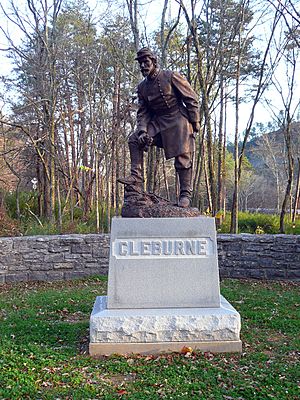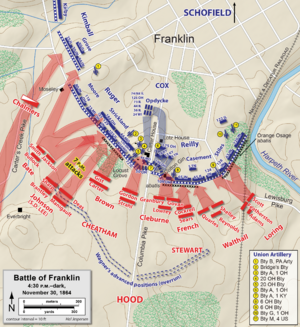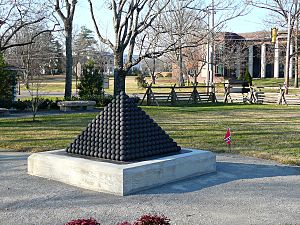Patrick Cleburne facts for kids
Quick facts for kids
Patrick Cleburne
|
|
|---|---|

Cleburne in uniform, c. 1862
|
|
| Birth name | Patrick Ronayne Cleburne |
| Nickname(s) | "Stonewall of the West" |
| Born | March 16, 1828 Ovens, County Cork, Ireland |
| Died | November 30, 1864 (aged 36) Franklin, Tennessee |
| Buried |
Helena Confederate Cemetery
(34°32′30″N 90°35′34″W / 34.54167°N 90.59278°W) |
| Allegiance | United Kingdom Confederate States |
| Service | British Army Confederate States Army |
| Years of service | 1846–1849 1861–1864 |
| Rank | |
| Unit | 41st Regiment of Foot (1846-49) |
| Battles | |
| Signature | |
Patrick Ronayne Cleburne (born March 16, 1828 – died November 30, 1864) was a skilled military leader. He became a major-general in the Confederate States Army. He led soldiers during the American Civil War, especially in the Western part of the conflict.
Cleburne was born in Ireland. He joined the British Army after not getting into medical school. Three years later, he moved to the United States. When the American Civil War began, Cleburne joined the Confederate side. He quickly rose from a regular soldier to a division commander. He fought in many important battles, including Shiloh, Stones River, and Chickamauga. He was known as the "Stonewall of the West" because he was so good at holding his ground. Sadly, Cleburne was killed while leading his troops at the Battle of Franklin.
Contents
Early Life and Moving to America
Patrick Ronayne Cleburne was born in Ovens, County Cork, Ireland. This was part of the United Kingdom at the time. He was the second son of Dr. Joseph Cleburne, a doctor. Patrick's mother passed away when he was very young, and he became an orphan at age 15.
He tried to follow his father's path and study medicine. However, he did not pass his entrance exam for Trinity College of Medicine in 1846. After this, he decided to join the British Army. He became a corporal in the 41st Regiment of Foot.
Cleburne served at Fort Westmorland on Spike Island. This was a large fort used as a prison. He saw many people suffering from famine there. This experience made him want to move to America with his family.
Three years after joining the British Army, Cleburne bought his way out of the army. He then moved to the United States with two brothers and a sister. After a short time in Ohio, he settled in Helena, Arkansas. There, he worked as a pharmacist. He quickly became a respected member of the community.
In Helena, Cleburne became good friends with Thomas C. Hindman. Hindman also became a Confederate major general later on. In 1855, the two friends bought a newspaper together called the Democratic Star.
In 1856, Cleburne and Hindman were involved in a street argument in Helena. Cleburne was shot in the back. He defended himself, and one of his attackers died. Cleburne collapsed, and the attackers left. After they recovered, Cleburne and Hindman were cleared of any wrongdoing. By 1860, Cleburne was a naturalized American citizen. He was also a practicing lawyer and well-liked by the people in Helena.
Fighting in the Civil War
When the Southern states started talking about leaving the United States, Cleburne chose to support them. He did not support slavery, but he felt a strong connection to the Southern people who had welcomed him. As the situation grew more serious, Cleburne joined a local volunteer army group called the Yell Rifles. He started as a private soldier but was soon chosen as their captain.
In January 1861, he led his company in taking over the U.S. Arsenal at Little Rock. When Arkansas left the Union, the Yell Rifles became part of the 1st Arkansas Infantry. Cleburne's regiment trained in Arkansas and Missouri. Later, they joined Albert Sidney Johnston's army. His regiment was renamed the 15th Arkansas. On March 4, 1862, Cleburne was promoted to brigadier general.
Cleburne fought bravely at the Battle of Shiloh. He led a brigade on the left side of the Confederate line. He also fought during the siege of Corinth. Later that year, Cleburne and his men moved to Tennessee. They were preparing for Braxton Bragg's attack into Kentucky. Cleburne's troops helped Edmund Kirby Smith's army lead the invasion.
At the Battle of Richmond in Kentucky, Cleburne was shot in the face. A bullet went through his left cheek, broke some teeth, and came out his mouth. But he recovered quickly. He rejoined the army and fought in the Battle of Perryville. After the army moved back to Tennessee, Cleburne was promoted to lead a division. He fought at the Battle of Stones River. His division pushed back the Union army's right side for three miles. On December 13, he was promoted to major general.
In 1863, Cleburne and his soldiers fought in Tennessee. They were at the Battle of Chickamauga. They also successfully held off a much larger Union force led by Major General William T. Sherman at the Battle of Missionary Ridge. Cleburne's men also protected the Confederate army during its retreat at the Battle of Ringgold Gap in Georgia. For their brave actions in this campaign, Cleburne and his troops received a special thanks from the Confederate Congress.
Cleburne was very good at using the land to his advantage. He could hold his position even when others failed. He was also skilled at stopping enemy movements. These talents earned him the nickname "Stonewall of the West." Union soldiers reportedly feared seeing the blue flag of Cleburne's Division on the battlefield. General Robert E. Lee even called him "a meteor shining from a clouded sky."
A Bold Idea: Enlisting Black Soldiers
By late 1863, Cleburne realized that the Confederacy was losing the war. They were running out of soldiers and supplies. In 1864, he gathered the leaders of the Army of Tennessee. He proposed a very bold idea: to free all enslaved people and allow them to join the Confederate Army. He believed this would help the South win its independence.
Cleburne argued that freeing enslaved people did not mean they had to be treated as equals. He thought that "necessity and wise laws" would keep relations between Black and white people mostly the same. His idea was met with silence at the meeting. Even though word of it spread, it was not officially recognized.
General William H. T. Walker, who strongly supported slavery, strongly disagreed with Cleburne's plan. Walker saw Cleburne as a rival. He convinced General Braxton Bragg, the army commander, that Cleburne could not be trusted politically. Because of this, Cleburne was passed over for promotion to corps commander three times in 1863. He remained a division commander until his death.
Death and Lasting Impact
Before the fighting season of 1864, Cleburne became engaged to Susan Tarleton. She was from Mobile, Alabama. Sadly, they never married. Cleburne was killed during a difficult attack on Union defenses at the Battle of Franklin. This battle took place near Nashville, Tennessee, on November 30, 1864. Cleburne had actually disagreed with this attack plan.
He was last seen walking towards the Union line with his sword raised. His horse had been shot from under him. Reports say he was found just inside the Union lines. His body was then taken to a medical station. Confederate records suggest he died from a shot to his stomach or possibly his heart. When Confederates found his body, valuable items like his sword, boots, and pocket watch had been taken.
Cleburne was first buried at Rose Hill Cemetery in Columbia, Tennessee. Later, his remains were moved to St. John's Episcopal Church. This church was near Mount Pleasant, Tennessee. He had seen the church during a march and said he would like to be buried there because it reminded him of Ireland. His remains stayed there for six years.
In 1870, Cleburne's body was moved again. He was taken back to his adopted hometown of Helena, Arkansas. There was a big ceremony. He was buried in the Confederate section of Maple Hill Cemetery, which overlooks the Mississippi River.
William J. Hardee, who was Cleburne's commander, spoke about his loss. He said that where Cleburne's division defended, no enemy could break their line. And where they attacked, no number of enemies could stop them, except once. That one time was where Cleburne died.
Several places are named after Patrick Cleburne. These include Cleburne County in Alabama and Arkansas. The city of Cleburne, Texas is also named after him. This city even has a statue of Patrick. The spot where he was killed in Franklin is now a park called Cleburne Park. The small monument there marks where the Carter Family Cotton Gin once stood, which was important during the battle.
The Patrick R. Cleburne Confederate Cemetery in Jonesboro, Georgia, is also named in his honor.
Images for kids
See also
- List of American Civil War generals
- Bibliography of the American Civil War
- Bibliography of Ulysses S. Grant






